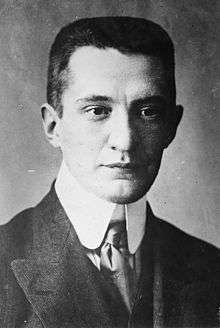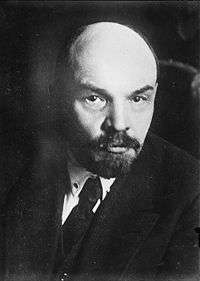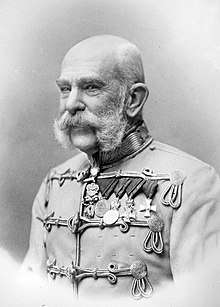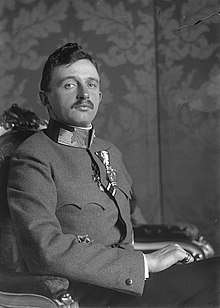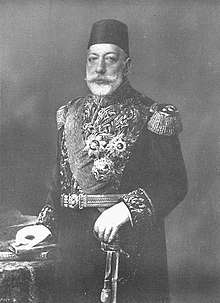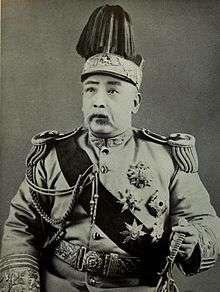1910s
The 1910s (pronounced "nineteen-tens", also abbreviated as the "teens") was a decade of the Gregorian calendar that began on January 1, 1910, and ended on December 31, 1919. The 1910s represented the culmination of European militarism which had its beginnings during the second half of the 19th century. The conservative lifestyles during the first half of the decade, as well as the legacy of military alliances, was forever changed by the assassination, on June 28, 1914, of Archduke Franz Ferdinand, the heir presumptive to the Austro-Hungarian throne. The murder triggered a chain of events in which, within 33 days, World War I broke out in Europe on August 1, 1914. The conflict dragged on until a truce was declared on November 11, 1918, leading to the controversial, one-sided Treaty of Versailles, which was signed on June 28, 1919.
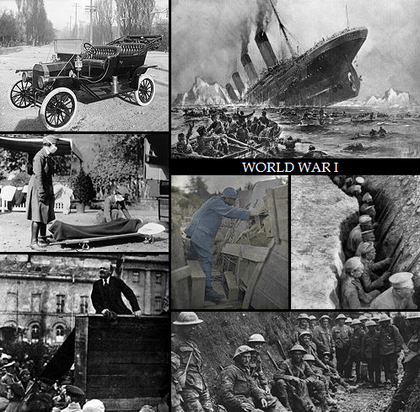
| Millennium: | 2nd millennium |
| Centuries: | |
| Decades: | |
| Years: | |
| Categories: |
|
The war's end triggered the abdication of various monarchies and the collapse of five of the last modern empires of Russia, Germany, China, Ottoman Turkey and Austria-Hungary, with the latter splintered into Austria, Hungary, southern Poland (who acquired most of their land in a war with Soviet Russia), Czechoslovakia and Yugoslavia, as well as the unification of Romania with Transylvania and Moldavia. However, each of these states (with the possible exception of Yugoslavia) had large German and Hungarian minorities, creating some unexpected problems that would be brought to light in the next two decades. (See Dissolution of Austro-Hungarian Empire: Successor States for better description of composition of names of successor countries/states following the splinter.)
The decade was also a period of revolution in a number of countries. The Portuguese 5 October 1910 revolution, which ended the eight-century long monarchy, spearheaded the trend, followed by the Mexican Revolution in November 1910, which led to the ousting of dictator Porfirio Diaz, developing into a violent civil war that dragged on until mid-1920, not long after a new Mexican Constitution was signed and ratified. The Russian Empire also had a similar fate, since its participation on World War I led it to a social, political and economical collapse which made the tsarist autocracy unsustainable and, as a following of the events of 1905, culminated in the Russian Revolution and the establishment of the Russian Soviet Federative Socialist Republic, under the direction of the Bolshevik Party later renamed as Communist Party of the Soviet Union. The Russian Revolution of 1917, known as the October Revolution, was followed by the Russian Civil War, which dragged on until approximately late 1922.
Much of the music in these years was ballroom-themed. Many of the fashionable restaurants were equipped with dance floors. Prohibition in the United States began January 16, 1919, with the ratification of the Eighteenth Amendment to the U.S. Constitution.
Politics and wars
Wars
- World War I (1914–1918)
- Assassination of Archduke Franz Ferdinand of Austria-Hungary in Sarajevo leads to the outbreak of the First World War
- Germany signs the Treaty of Versailles after losing the first world war.
- Armenian Genocide during and just after World War I. It was characterised by the use of massacres and deportations involving forced marches under conditions designed to lead to the death of the deportees, with the total number of Armenian deaths generally held to have been between one and one-and-a-half million.[1][2][3]
- Wadai War (1909–1911)
- Italo-Turkish War (1911–1912)
- First Balkan Wars (1912–1913) – two wars that took place in South-eastern Europe in 1912 and 1913.
- Saudi-Ottoman War (1913)
- Latvian War of Independence (1918-1920) – a military conflict in Latvia between the Republic of Latvia and the Russian SFSR.
Internal conflicts
- October Revolution in Russia results in the overthrow of capitalism and the establishment of the world's first self-proclaimed socialist state; political upheaval in Russia culminating in the establishment of the Russian SFSR and the assassination of Emperor Nicholas II and the royal family.
- The Russian Revolution (1917) is the collective term for the series of revolutions in Russia in 1917, which destroyed the Tsarist autocracy and led to the creation of the Soviet Union.
- April 13, 1919 – The Jallianwala Bagh massacre, at Amritsar in the Punjab Province of British India, sows the seeds of discontent and leads to the birth of the Indian Independence Movement.
- Xinhai Revolution causes the overthrow of China's ruling Qing Dynasty, and the establishment of the Republic of China (1912-1949).
- Mexican Revolution (1910–1920) Francisco I. Madero proclaims the elections of 1910 null and void, and calls for an armed revolution at 6 p.m. against the illegitimate presidency/dictatorship of Porfirio Díaz. The revolution lead to the ousting of Porfirio Díaz (who ruled from 1876 to 1880 and since 1884) six months later. The Revolution progressively becomes a civil war with multiple factions and phases, culminating with the Mexican Constitution of 1917, but combat would persist for three more years.
Major political changes
- Portugal becomes the first republican country in the century after the 5 October 1910 revolution, ending its long-standing monarchy and creating the First Portuguese Republic in 1911.
- Germany abolishes its monarchy and becomes under the rule of a new elected government called the Weimar Republic.
- Federal Reserve Act is passed by United States Congress, establishing a Central Bank in the US.
- George V becomes king in Britain.
- Dissolution of the German colonial empire, Ottoman Empire, Austria-Hungary and the Russian Empire, reorganization of European states, territorial boundaries, and the creation of several new European states and territorial entities: Austria, Czechoslovakia, Estonia, Finland, Free City of Danzig, Hungary, Latvia, Lithuania, Poland, Saar, Ukraine, and Yugoslavia.
- Fourteen Points as designed by United States President Woodrow Wilson advocates the right of all nations to self-determination.
- Rise to power of the Bolsheviks in Russia under Vladimir Lenin, creating the Russian Soviet Federated Socialist Republic, the first state committed to the establishment of communism.
Decolonization and independence
- Easter Rising against the British in Ireland; eventually leads to Irish independence.
- Several nations in Eastern Europe get their own nation state, thereby replacing major multiethnic empires.
- The Republic of China is established on January 1, 1912.
Prominent political events
Assassinations and attempts
Prominent assassinations, targeted killings, and assassination attempts include:
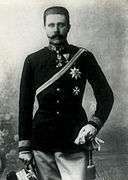
- March 18, 1913: George I of Greece
- June 11, 1913: Mahmud Şevket Pasha, Grand Vizier of the Ottoman Empire
- June 28, 1914 — Archduke Franz Ferdinand of Austria-Hungary is assassinated in Sarajevo, Bosnia and Herzegovina; prompting the events that led up to the start of World War I.
- July 17, 1918: Shooting of former Russian Emperor Nicholas II, his consort, their five children, and four retainers at the Ipatiev House in Yekaterinburg, Russian Soviet Federative Socialist Republic following the October Revolution of 1917, and the usurpation of power by the Bolsheviks.
- April 10, 1919: Emiliano Zapata
Disasters
.jpg)
- The RMS Titanic, a British ocean liner which was the largest and most luxurious ship at that time, struck an iceberg and sank 2 hours and forty minutes later in the North Atlantic during its maiden voyage on April 15, 1912. 1,517 people perished in the disaster.
- On November 21, 1916 HMHS Britannic was holed in an explosion while passing through a channel which had been seeded with enemy mines and sank in 55 minutes.
- On May 7, 1915, the British ocean liner RMS Lusitania was torpedoed by U-20, a German U-boat, off the Old Head of Kinsale in Ireland and sunk in 18 minutes. 1,198 lives were lost, including 128 Americans. The sinking proved to be a factor in the American decision to enter World War I two years later.
- From 1918 through 1920, the Spanish flu killed from 50 to 100 million people worldwide.
- In 1916, the Netherlands was hit by a North Sea storm that flooded the lowlands and killed 19 people.
- From July 1 to July 12, 1916, a series of shark attacks, known as the Jersey Shore shark attacks of 1916 occurred along the Jersey Shore killing four and injuring one.
- On January 11, 1914, Sakurajima erupted which resulted in the death of 35 people. In addition to that, the surrounding islands were consumed. Also an isthmus was created between Sakurajima and the main land.
- In 1917, the Halifax explosion killed 2,000 people.
Other significant international events
- The Panama Canal is completed in 1914.
- World War I from 1914 until 1918 dominates the Western world.
- Hiram Bingham rediscovers Machu Picchu on July 24, 1911.
Science and technology
Technology
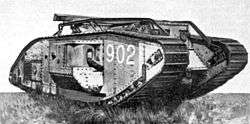
- Gideon Sundback patented the first modern zipper.[4]
- Harry Brearley invented stainless steel.[5]
- Charles Strite invented the first pop-up bread toaster.[6][7]
- The Model T Ford dominated the automobile market, selling more than all other makers combined in 1914.[8]
- The army tank was invented. Tanks in World War I were used by the British Army, the French Army and the German Army.[9]
Science
- In 1916, Albert Einstein's theory of general relativity.[10]
- Max von Laue discovers the diffraction of x-rays by crystals.[11]
- In 1912, Alfred Wegener puts forward his theory of continental drift.[12]
Economics
- In the years 1910 and 1911, there was a minor economic depression known as the Panic of 1910–11, which was followed by the enforcement of the Sherman Anti-Trust Act.
Popular culture
- Radio programming becomes popular.
- Flying Squadron of America promotes temperance movement in the United States.
- Edith Smith Davis edits the Temperance Educational Quarterly.
- The first U.S. feature film, Oliver Twist, was released in 1912.
- The first mob film, D. W. Griffith's The Musketeers of Pig Alley was released in 1912.
- Hollywood, California, replaces the East Coast as the center of the movie industry.
- The first crossword puzzle was published in 1913.
- The comic strip Krazy Kat begins.
- Charlie Chaplin débuts his trademark mustached, baggy-pants "Little Tramp" character in Kid Auto Races at Venice in 1914.
- The first African American owned studio, the Lincoln Motion Picture Company, was founded in 1917.
- The four Warner brothers, (from older to younger) Harry, Albert, Samuel, and Jack opened their first major film studio in Burbank in 1918.
- Tarzan of the Apes starring Elmo Lincoln is released in 1918, the first Tarzan film.
- The first jazz music is recorded.
- The Salvation Army has a new international leader, General Bramwell Booth who served from 1912 to 1929. He replaces his father and co-founder of the Christian Mission (the forerunner of the Salvation Army), William Booth.
Sports
- 1912 Summer Olympics were held in Stockholm, Sweden.
- 1916 Summer Olympics were cancelled because of World War I.
Literature and arts
- D. H. Lawrence publishes Sons and Lovers
- Of Human Bondage by Somerset Maugham is published
- Tarzan of the Apes by Edgar Rice Burroughs is published
- Zane Grey's Wild Fire is published
- Dubliners and A Portrait of the Artist as a Young Man by James Joyce are published
- Pygmalion by George Bernard Shaw is published
- Thomas Mann publishes Death in Venice
- Willa Cather publishes Alexander's Bridge, O Pioneers!, The Song of the Lark and My Ántonia
- End of Art Nouveau and beginning of Art Deco
Visual Arts
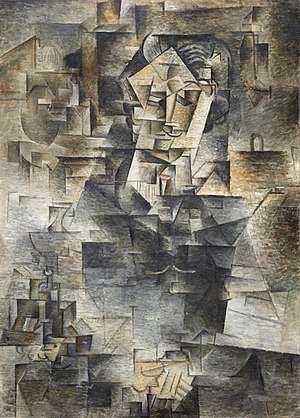 Pablo Picasso, Portrait of Daniel-Henry Kahnweiler, 1910, The Art Institute of Chicago. Pablo Picasso and Georges Braque co-invent Cubism, revolutionizing the art of painting and advancing the concepts of Modern art and Modernism.
Pablo Picasso, Portrait of Daniel-Henry Kahnweiler, 1910, The Art Institute of Chicago. Pablo Picasso and Georges Braque co-invent Cubism, revolutionizing the art of painting and advancing the concepts of Modern art and Modernism. Henri Matisse, L'Atelier Rouge, 1911, oil on canvas, 162 × 130 cm., The Museum of Modern Art, New York City
Henri Matisse, L'Atelier Rouge, 1911, oil on canvas, 162 × 130 cm., The Museum of Modern Art, New York City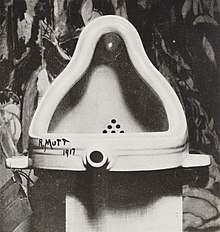 Marcel Duchamp, Fountain, 1917, Duchamp introduces his Readymades, as an example of Dada and Anti-art. Photograph by Alfred Stieglitz
Marcel Duchamp, Fountain, 1917, Duchamp introduces his Readymades, as an example of Dada and Anti-art. Photograph by Alfred Stieglitz Armory Show poster, 1913, Internationally groundbreaking exhibition of Modern art
Armory Show poster, 1913, Internationally groundbreaking exhibition of Modern art
The 1913 Armory Show in New York City was a seminal event in the history of Modern Art. Innovative contemporaneous artists from Europe and the United States exhibited together in a massive group exhibition in New York City, and Chicago.
Art movements
Cubism and related movements
Expressionism and related movements
- Symbolism
- Blaue Reiter
- Die Brücke
Geometric abstraction and related movements
Other movements and techniques
Influential artists
People
World leaders
- President Armand Fallières (France)
- President Raymond Poincaré (France)
- President du Conseil Georges Clemenceau (France)
- Kaiser Wilhelm II (Germany)
- Chancellor Theobald von Bethmann Hollweg (Germany)
- King Carol I (Romania)
- King Ferdinand I (Romania)
- Prime Minister Alfred Deakin (Australia)
- Prime Minister Andrew Fisher (Australia)
- Prime Minister Joseph Cook (Australia)
- Prime Minister Billy Hughes (Australia)
- Emperor Franz Josef (Austria-Hungary)
- Emperor Karl (Austria-Hungary)
- Prime Minister Sir Robert Borden (Canada)
- Emperor Henry Pu Yi of the Qing Dynasty (China)
- Sun Yat-sen, President of the Republic of China
- Yuan Shikai, President of the Republic of China and briefly Emperor
- Xu Shichang, President of the Republic of China
- Sultan Hussein Kamel of Egypt
- Sultan Fuad I of Egypt
- King Victor Emmanuel III (Italy)
- Pope Pius X
- Pope Benedict XV
- Sultan Vahidettin (Ottoman Empire)
- Ahmad Shah Qajar (Persia)
- Tsar Nicholas II (Russia)
- Minister-Chairman Georgy Lvov (Russia)
- Minister-Chairman Alexander Kerensky (Russia)
- Chairman Vladimir Lenin (Russia)
- King Peter I of Serbia
- King Alfonso XIII (Spain)
- Prime Minister José Canalejas (Spain)
- Prime Minister Eduardo Dato Iradier (Spain)
- George V (United Kingdom of Great Britain and Ireland)
- Prime Minister H. H. Asquith (United Kingdom of Great Britain and Ireland)
- Prime Minister David Lloyd George (United Kingdom of Great Britain and Ireland)
- President William Howard Taft (United States)
- President Woodrow Wilson (United States)
Politics
- John Barrett, Director-general Organization of American States
- Georges Louis Beer, Chairman Permanent Mandates Commission
- Henry P. Davison, Chairman International Federation of Red Cross and Red Crescent Societies
- Sir James Eric Drummond, Secretary-general League of Nations
- Emil Frey, Director International Telecommunication Union
- Christian Louis Lange, Secretary-general Inter-Parliamentary Union
- Baron Louis Paul Marie Hubert Michiels van Verduynen, Secretary-general Permanent Court of Arbitration
- William E. Rappard, Secretary-general International Federation of Red Cross and Red Crescent Societies
- Manfred von Richthofen, alias the "Red Baron", fighter pilot
- Eugène Ruffy, Director Universal Postal Union
- William Napier Shaw, President World Meteorological Organization
- Albert Thomas, Director International Labour Organization
- Grigory Yevseyevich Zinoviev, Chairman of the Executive Committee Communist International
Business
- Arnold Rothstein, gangster, gambler, fixed the 1919 World Series
- Henry Ford, industrialist, founder of the Ford Motor Company
Inventors
- Nikola Tesla, electrical and mechanical engineer
Authors
Entertainers
- Fatty Arbuckle
- Theda Bara
- Richard Barthelmess
- Béla Bartók
- Irving Berlin
- Ben Black
- Eubie Blake
- Shelton Brooks
- Lew Brown
- Tom Brown
- Anne Caldwell
- Eddie Cantor
- Enrico Caruso
- Charlie Chaplin
- Lon Chaney
- George M. Cohan
- Henry Creamer
- Bebe Daniels
- Cecil B. DeMille
- Buddy De Sylva
- Walter Donaldson
- Marie Dressler
- Eddie Edwards
- Gus Edwards
- Douglas Fairbanks
- Fred Fisher
- John Ford
- Eddie Foy
- George Gershwin
- Beniamino Gigli
- Dorothy Gish
- Lillian Gish
- Samuel Goldwyn
- D. W. Griffith
- W. C. Handy
- Otto Harbach
- Lorenz Hart
- Victor Herbert
- Harry Houdini
- Charles Ives
- Tony Jackson
- Emil Jannings
- William Jerome
- Al Jolson
- Gus Kahn
- Gustave Kahn
- Buster Keaton
- Jerome David Kern
- Ring Lardner
- Nick LaRocca
- Harry Lauder
- Florence Lawrence
- Ted Lewis
- Harold Lloyd
- Charles McCarron
- Joseph McCarthy
- Winsor McCay
- Oscar Micheaux
- Mae Murray
- Alla Nazimova
- Pola Negri
- Anna Q. Nilsson
- Ivor Novello
- Alcide Nunez
- Geoffrey O'Hara
- Sidney Olcott
- Jack Pickford
- Mary Pickford
- Armand J. Piron
- Cole Porter
- Richard Rodgers
- Sigmund Romberg
- Jean Schwartz
- Mack Sennett
- Larry Shields
- Chris Smith
- Erich von Stroheim
- Arthur Sullivan
- Gloria Swanson
- Wilber Sweatman
- Blanche Sweet
- Albert Von Tilzer
- Harry Von Tilzer
- Sophie Tucker
- Pete Wendling
- Pearl White
- Bert Williams
- Clarence Williams
- Harry Williams
- Spencer Williams
- P. G. Wodehouse
- Mabel Normand
Sports figures
Baseball

- Babe Ruth, (American baseball player)
- Honus Wagner, (American baseball player)
- Christy Mathewson, (American baseball player)
- Walter Johnson, (American baseball player)
- Ty Cobb, (American baseball player)
- Tris Speaker, (American baseball player)
- Nap Lajoie, (American baseball player)
- Eddie Collins, (American baseball player)
- Mordecai Brown, (American baseball player)
Olympics
Boxing
See also
References
- Dictionary of Genocide, by Samuel Totten, Paul Robert Bartrop, Steven L. Jacobs, Greenwood Publishing Group, 2008, ISBN 0-313-34642-9, p. 19
- Intolerance: a general survey, by Lise Noël, Arnold Bennett, 1994, ISBN 0773511873, p. 101
- Encyclopedia of Race, Ethnicity, and Society, by Richard T. Schaefer, 2008, p. 90
- Friedel, Robert D (1996). Zipper : an Exploration in Novelty. New York: Norton. p. 94. ISBN 0393313654. OCLC 757885297.
- "A Non-Rusting Steel: Sheffield Invention Especially Good for Table Cutlery" (PDF). The New York Times. 1914-01-31. Retrieved 2017-05-11.
- "Bread-toaster" (Patent #1,387,670 application filed May 29, 1919, granted August 16, 1921). Google Patents. Retrieved 30 January 2018.
- "Patent for Bread-Toaster Issued October 18, 1921" (Patent #1,394,450 application filed June 22, 1920, granted October 18, 1921). United States Patent and Trademark Office. Retrieved 30 January 2018.
- Brinkley, Douglas (2004). Wheels for the world : Henry Ford, his company, and a century of progress, 1903-2003. Penguin Books. ISBN 9780142004395. OCLC 796971541.
- Watson, Greig (2014-02-24). "World War One: The tank's secret Lincoln origins". BBC News. Retrieved 2017-05-11.
- O'Conner, J.J.; Robertson, E.F. (May 1996). "General relativity". www.st-andrews.ac.uk. University of St. Andrews. Retrieved 2017-05-11.
- "Gerade auf LeMO gesehen: LeMO Bestand: Biografie". www.dhm.de (in German). Stiftung Deutsches Historisches Museum. 2014-09-14. Retrieved 2017-05-11.
- Demhardt, Imre (2012) [1912]. "Alfred Wegeners Hypothesis on Continental Drift and its Discussion in Petermanns Geographische Mitteilungen" (PDF). Polarforschung. 75: 29–35. Archived from the original (PDF) on 2011-10-04.
Further reading
| Wikimedia Commons has media related to 1910s. |
- Chisholm, Hugh (1913). Britannica Year-book 1913. pp. 1 v. (covers 1910-1912)
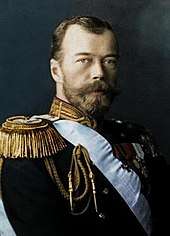

.jpg)

.jpg)



